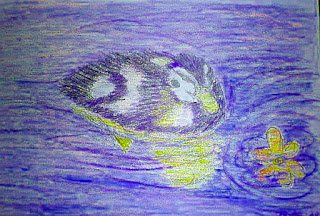I think I have uploaded these pics before, but just in case people may have missed out, here they are again. I am very proud of these pictures, even though it was a class project with Open Colleges. However, I put my own touches to it to make them 'mine'.
So what is the significance of rabbits (or hares) and eggs (chickens) during Easter time?
Some say it is based on a Germanic Tradition (Easter-tide or the Neo-Pagan Ostara) - a rabbit brings Easter eggs to children who have behaved well in the weeks preceding Easter.
Often, the rabbit is associated with fertility: female bunnies start breeding when they young and may even conceive another litter whilst still pregnant with the first (a process called 'superfetation').
Here is what Wikipedia has to say:
Rabbits and hares
The hare was a popular motif in medieval church art. In ancient times, it was widely believed (as by Pliny, Plutarch, Philostratus, and Aelian) that the hare was a hermaphrodite.[4][5][6] The idea that a hare could reproduce without loss of virginity led to an association with the Virgin Mary, with hares sometimes occurring in illuminated manuscripts and Northern European paintings of the Virgin and Christ Child. It may also have been associated with the Holy Trinity, as in the three hares motif.[4][7] Eggs, like rabbits and hares, are fertility symbols[8] of antiquity. Since birds lay eggs and rabbits and hares give birth to large litters in the early spring, these became symbols of the rising fertility of the earth at the Vernal Equinox.
Rabbits and hares are both prolific breeders. Female hares can conceive a second litter of offspring while still pregnant with the first.[9][10] This phenomenon is known as superfetation. Lagomorphs mature sexually at an early age and can give birth to several litters a year (hence the saying, "to breed like rabbits" or "to breed like bunnies"). It is therefore not surprising that rabbits and hares should become fertility symbols, or that their springtime mating antics should enter into Easter folklore.Eggs
Main articles: Easter egg and Egg decorating
In addition, Orthodox churches have a custom of abstaining from eggs during the fast of Lent. The only way to keep them from being wasted was to boil or roast them, and begin eating them to break the fast.[citation needed] As a special dish, they would probably have been decorated as part of the celebrations. Later, German Protestants retained the custom of eating coloured eggs for Easter, though they did not continue the tradition of fasting.[11] Eggs boiled with some flowers change their colour, bringing the spring into the homes, and some over time added the custom of decorating the eggs.[12] Many Christians of the Eastern Orthodox Church to this day typically dye their Easter eggs red,[13] the colour of blood, in recognition of the blood of the sacrificed Christ (and, of the renewal of life in springtime). Some also use the colour green, in honour of the new foliage emerging after the long-dead time of winter. The Ukrainian art of decorating eggs for Easter, known as pysanky, dates to ancient, pre-Christian times. Similar variants of this form of artwork are seen amongst other eastern and central European cultures.[14]
The idea of an egg-giving hare went to the U.S. in the 18th century. Protestant German immigrants in the Pennsylvania Dutch area told their children about the "Osterhase" (sometimes spelled "Oschter Haws"[15]). Hase means "hare", not rabbit, and in Northwest European folklore the "Easter Bunny" indeed is a hare. According to the legend, only good children received gifts of coloured eggs in the nests that they made in their caps and bonnets before Easter.[16]
That is just an excerpt from this Wikipedia article, and you can read the whole article here.
It is also interesting to note (according to alot of my Greek friends) that the Greeks and other Orthodox Christians not only celebrate Easter later than the other Christian Denominations, but they also have hard-boiled eggs where they dye the shells to give them their bright colours. I am not sure why the dates are different for the Orthodox Christians, but now I know why they have boiled eggs (to make sure they keep until then).
I mostly like to associate it with eating lots of chocolate, and going to the show (two things that used to give me great joy when I was still a child). And, as most of you will know, I have a real *soft spot* for cuddly animals, so if that is not a good reason to celebrate, then I don't know what is.
Anyway, my dear friends, wishing you all a Happy Easter, regardless of your beliefs.
cheers,
Colleen 🐇🐰🐔🐣🐤🐥


Comments
Post a Comment
Thank you for your feedback. The moderator will soon moderate your comments and say 'yay' or 'nay'. Any posts that aren't relevant to the topic of this blog will be rejected immediately.